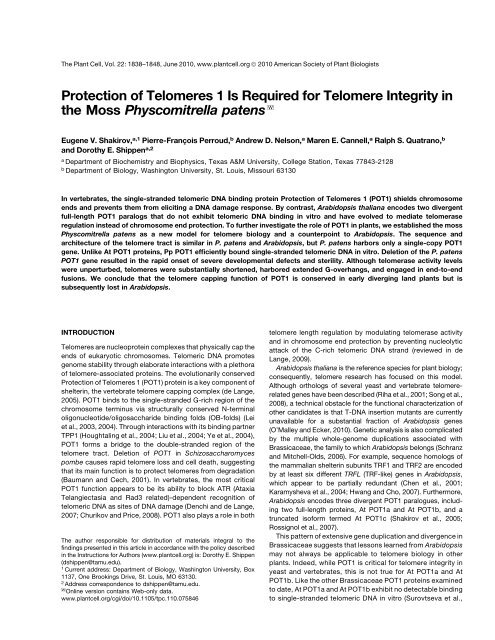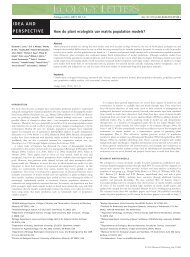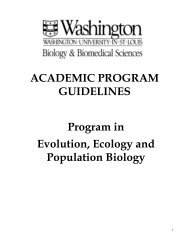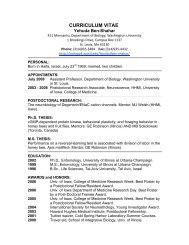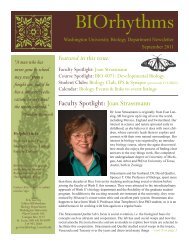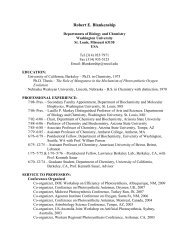Abstract/PDF - Department of Biology - Washington University in St ...
Abstract/PDF - Department of Biology - Washington University in St ...
Abstract/PDF - Department of Biology - Washington University in St ...
Create successful ePaper yourself
Turn your PDF publications into a flip-book with our unique Google optimized e-Paper software.
POT1 <strong>in</strong> Physcomitrella patens 1841Figure 3. Characterization <strong>of</strong> Pp POT1 Interaction with Telomeric DNA <strong>in</strong> Vitro.(A) EMSA was performed with a cocktail <strong>of</strong> seven 32 P-labeled oligonucleotides correspond<strong>in</strong>g to two (2TELO) (lanes 1 to 3) or three (3TELO) (lanes 4 and5) TTTAGGG repeats. Unprogrammed RRL reactions lack<strong>in</strong>g external DNA template were used as negative controls (lanes 1 and 4), and a reaction withasparagus POT1 prote<strong>in</strong> (Ao POT1) was performed as a positive control (lane 3). Pp POT1 b<strong>in</strong>ds 3TELO probe (lane 5) but not 2TELO probe (lane 2).(B) Identification <strong>of</strong> the Pp POT1 m<strong>in</strong>imum DNA b<strong>in</strong>d<strong>in</strong>g site. Equal amounts <strong>of</strong> RRL-expressed Pp POT1 were <strong>in</strong>cubated with the <strong>in</strong>dicated radioactivelylabeled oligonucleotides (bottom panel), and prote<strong>in</strong>-DNA complexes were separated by native PAGE.3A, lane 2), Pp POT1 efficiently bound the 3TELO cocktail (Figure3A, lane 5). As expected (Surovtseva et al., 2007; Shakirov et al.,2009a), POT1 prote<strong>in</strong>s from Arabidopsis and several other vascularplants showed no detectable telomeric DNA b<strong>in</strong>d<strong>in</strong>g (seeSupplemental Figure 1 onl<strong>in</strong>e). Of the seven <strong>in</strong>dividual permutations<strong>in</strong> the 3TELO cocktail probe, Pp POT1 bound (AGGGTTT) 3most efficiently (see Supplemental Figure 2 onl<strong>in</strong>e).The m<strong>in</strong>imum DNA b<strong>in</strong>d<strong>in</strong>g site (MBS) <strong>in</strong> vertebrate POT1prote<strong>in</strong>s is highly conserved and consists <strong>of</strong> 10 to 12 nucleotides(Lei et al., 2004; Loayza et al., 2004; Wei and Price, 2004; Heet al., 2006). To def<strong>in</strong>e the Pp POT1 MBS, we performed EMSAwith (AGGGTTT) 3 and a series <strong>of</strong> s<strong>in</strong>gle nucleotide truncationsfrom either the 59 or 39 end <strong>of</strong> this substrate (Figure 3B). Removal<strong>of</strong> the first two nucleotides from both ends <strong>of</strong> the substrate(oligonucleotide 17) did not decrease b<strong>in</strong>d<strong>in</strong>g. However, deletion<strong>of</strong> one additional nucleotide from the 39 end, but not from the 59end <strong>of</strong> this substrate, completely abolished b<strong>in</strong>d<strong>in</strong>g (Figure 3B,compare oligonucleotides 16 and 169). S<strong>in</strong>ce Pp POT1 does notb<strong>in</strong>d to two different oligonucleotides conta<strong>in</strong><strong>in</strong>g 15 nucleotideseach (see Supplemental Figure 3A onl<strong>in</strong>e), we conclude that itsm<strong>in</strong>imum tight b<strong>in</strong>d<strong>in</strong>g substrate is the 16-nucleotide sequence,GTTTAGGGTTTAGGGT.We next asked which doma<strong>in</strong>(s) <strong>in</strong> the P. patens POT1 arerequired for MBS recognition. Like POT1 prote<strong>in</strong>s from vertebratesand several plants (Lei et al., 2004; He et al., 2006; Wuet al., 2006; Shakirov et al., 2009b), both N-term<strong>in</strong>al OB-foldswere necessary for telomeric DNA b<strong>in</strong>d<strong>in</strong>g (see SupplementalFigure 3B onl<strong>in</strong>e, lanes 4 to 7). Interest<strong>in</strong>gly, the EMSA pr<strong>of</strong>ilechanged from a s<strong>in</strong>gle band to a smear <strong>in</strong> the absence <strong>of</strong> PpPOT1 C term<strong>in</strong>us (see Supplemental Figure 3B onl<strong>in</strong>e, comparelanes 2 and 3), suggest<strong>in</strong>g that this region (am<strong>in</strong>o acids 323 to497) modulates Pp POT1 <strong>in</strong>teraction with DNA <strong>in</strong> vitro.In mammalian and fission yeast POT1 prote<strong>in</strong>s, an <strong>in</strong>variantPhe <strong>in</strong> the first OB-fold (F62 <strong>in</strong> human POT1; Figure 2A) isrequired for efficient DNA b<strong>in</strong>d<strong>in</strong>g (Lei et al., 2004; He et al., 2006;Wu et al., 2006). To test if the correspond<strong>in</strong>g residue (F74) isrequired for telomeric DNA <strong>in</strong>teraction by Pp POT1, we performedEMSA with an F74A Pp POT1 mutant. The mutant prote<strong>in</strong>failed to b<strong>in</strong>d telomeric DNA <strong>in</strong> vitro (see Supplemental Figure 3Bonl<strong>in</strong>e, lane 1). Altogether, these data <strong>in</strong>dicate that P. patensPOT1 is a bona fide s<strong>in</strong>gle-stranded telomeric DNA b<strong>in</strong>d<strong>in</strong>gprote<strong>in</strong> with structural and biochemical properties similar toPOT1 prote<strong>in</strong>s from yeast and vertebrates but dist<strong>in</strong>ct fromArabidopsis.Morphological and Developmental Defects <strong>in</strong> theDpot1 <strong>St</strong>ra<strong>in</strong>We generated a deletion <strong>of</strong> P. patens POT1 (Dpot1) by replac<strong>in</strong>gits complete open read<strong>in</strong>g frame (ORF) with the hygromyc<strong>in</strong>resistance gene HptII (see Supplemental Figure 4A onl<strong>in</strong>e). Theabsence <strong>of</strong> the POT1 ORF <strong>in</strong> hygromyc<strong>in</strong>-resistant transformantswas verified by PCR genotyp<strong>in</strong>g (see Supplemental Figure 4Bonl<strong>in</strong>e), DNA gel blot analysis (see Supplemental Figure 4Conl<strong>in</strong>e), and by sequenc<strong>in</strong>g across the entire Dpot1 locus. RT-PCR confirmed the absence <strong>of</strong> POT1 mRNA <strong>in</strong> Dpot1 (Figure 2B,lanes 3 and 4). Hereafter, we refer to Dpot1 as a null mutant.P. patens was able to grow vegetatively <strong>in</strong> the absence <strong>of</strong>POT1, suggest<strong>in</strong>gthatthisgeneisnotessentialforlong-termmoss survival. Nevertheless, the Dpot1 stra<strong>in</strong> displayed a
POT1 <strong>in</strong> Physcomitrella patens 1843wild-type P. patens generated a smear spann<strong>in</strong>g up to 0.5 kb(Figure 4C), but <strong>in</strong> Dpot1, both A and B telomeres were >200 bpshorter (Figure 4C). Importantly, the wild-type PETRA pr<strong>of</strong>ile wasrestored <strong>in</strong> Dpot1-Pp-POT1 (see Supplemental Figure 8B onl<strong>in</strong>e).Telomerase activity is reduced by ;10-fold <strong>in</strong> Arabidopsisplants null for At POT1a (Surovtseva et al., 2007). To determ<strong>in</strong>e if<strong>in</strong> vitro telomerase activity is altered <strong>in</strong> Dpot1, we performed thequantitative telomere repeat amplification protocol (Kannanet al., 2008) with prote<strong>in</strong> extracts from wild-type and Dpot1stra<strong>in</strong>s. No statistically significant difference <strong>in</strong> enzyme activitywas observed (see Supplemental Figure 9 onl<strong>in</strong>e). We concludethat POT1 prote<strong>in</strong>s make fundamentally different contributions totelomere ma<strong>in</strong>tenance <strong>in</strong> Arabidopsis and P. patens.Defects <strong>in</strong> Telomere Architecture and Genome <strong>St</strong>ability<strong>in</strong> Dpot1Mutations <strong>in</strong> telomere capp<strong>in</strong>g prote<strong>in</strong>s can lead to <strong>in</strong>creasedG-overhang length, result<strong>in</strong>g from <strong>in</strong>creased nucleolytic attackon the C-rich telomeric strand or uncoupled replication <strong>of</strong> theG-rich and C-rich strands (L<strong>in</strong>ger and Price, 2009). We analyzedG-overhang status <strong>in</strong> Dpot1 mutants us<strong>in</strong>g the <strong>in</strong>-gel hybridizationassay. DNA gel blott<strong>in</strong>g with a telomeric DNA probe wasperformed under native conditions to measure s<strong>in</strong>gle-strandedtelomeric DNA. The gel was rehybridized with the same probeunder denatur<strong>in</strong>g conditions to normalize for the total amount <strong>of</strong>double- and s<strong>in</strong>gle-stranded telomeric DNA loaded. Relative tothe wild type, the G-overhang signal <strong>in</strong> Dpot1 <strong>in</strong>creased byapproximately eightfold (Figures 5A, lanes 1 and 3, and 5B).Exonuclease treatment confirmed that hybridization was associatedwith the chromosome term<strong>in</strong>us (Figure 5A, lanes 2 and 4).We conclude that P. patens POT1 is critical for proper chromosomeend structure.S. pombe and mammalian POT1 prote<strong>in</strong>s are required toprotect chromosomes from end-to-end fusions (Baumann andCech, 2001; Veldman et al., 2004; He et al., 2006; Hockemeyeret al., 2006). By contrast, Arabidopsis POT1a and POT1b nullmutants do not exhibit telomere fusions (Surovtseva et al., 2007;E.V. Shakirov, A.D. Nelson, and D.E. Shippen, unpublished data).To evaluate chromosome stability <strong>in</strong> Dpot1, we employed thetelomere fusion PCR assay (TF-PCR) (Heacock et al., 2004). Aswith PETRA, TF-PCR uses unique subtelomere-specific PCRprimers directed toward the chromosome term<strong>in</strong>us. If the targetchromosome ends are covalently fused, the fusion junction willbe amplified and detected by DNA gel blot analysis. As expected,no TF-PCR products were observed with DNA samplesfrom wild-type P. patens or <strong>in</strong> the complemented Dpot1-Pp-POT1 stra<strong>in</strong> (see Supplemental Figure 8C onl<strong>in</strong>e). However TF-PCR products were abundant <strong>in</strong> reactions with Dpot1 DNA(Figure 6A). Interest<strong>in</strong>gly, chromosome fusions were also detected<strong>in</strong> Dpot1 PCR reactions conta<strong>in</strong><strong>in</strong>g only one subtelomerespecificprimer (Figure 6B). S<strong>in</strong>ce P. patens spends most <strong>of</strong> itslifecycle <strong>in</strong> the haploid form, these data suggest that sisterchromatids fuse <strong>in</strong> the absence <strong>of</strong> POT1.Chromosome end ma<strong>in</strong>tenance defects worsen over time <strong>in</strong>mouse models deficient for either mPOT1a or mPOT1b (Wuet al., 2006; Hockemeyer et al., 2008). By contrast, we found noevidence <strong>of</strong> progressive telomere shorten<strong>in</strong>g or <strong>in</strong>creased <strong>in</strong>cidence<strong>of</strong> telomere fusions <strong>in</strong> long-term vegetatively grow<strong>in</strong>gDpot1 cultures. However, s<strong>in</strong>ce relatively few cultured P. patenscells are proliferat<strong>in</strong>g (Cove et al., 2006), it is possible that thetelomere deprotection phenotype would be exacerbated if themajority <strong>of</strong> Dpot1 cells were forced to divide. To <strong>in</strong>vestigate thispossibility, we subjected Dpot1 cells to several consecutiverounds <strong>of</strong> colony regrowth from a s<strong>in</strong>gle progenitor cell (protoplast)(Figure 6C). As predicted, the abundance <strong>of</strong> TF-PCRproducts was elevated <strong>in</strong> Dpot1 cultures as the number <strong>of</strong>protoplast<strong>in</strong>g and new colony formation events <strong>in</strong>creased (Figure6C). Taken together, our data <strong>in</strong>dicate that POT1 is essential fortelomere <strong>in</strong>tegrity and chromosome end protection <strong>in</strong> P. patens.Figure 5. Increased G-Overhang Signals <strong>in</strong> Dpot1 Mutants.(A) In-gel hybridization results us<strong>in</strong>g a G-strand specific probe (C 3 TA 3 ) 4 to detect telomeric DNA under native (lanes 1 to 4) and denatur<strong>in</strong>g (lanes 5 to 8)conditions <strong>in</strong> the wild type (wt) and Dpot1. T4 DNA Polymerase (a 39/59 exonuclease [Exo]) was added to reactions shown <strong>in</strong> lanes designated by (+).(B) Quantification <strong>of</strong> the G-overhang signal <strong>in</strong> (A). Dpot1 signal <strong>in</strong>tensity relative to the wild type is shown (error bars measured for n =4,SD is 6 0.835).
1844 The Plant CellFigure 6. Accumulation <strong>of</strong> Chromosome Fusions <strong>in</strong> Dpot1.(A) and (B) TF-PCR detects multiple <strong>in</strong>stances <strong>of</strong> end-to-end chromosomefusions <strong>in</strong> Dpot1 moss but not <strong>in</strong> the wild type (wt). TF-PCR resultswith subtelomeric primers specific for chromosome arms A and B andDNA from three <strong>in</strong>dividual colonies <strong>of</strong> the wild type or Dpot1 (A).TF-PCRresults with one subtelomeric primer specific for chromosome arm B (B).(C) Increased <strong>in</strong>cidence <strong>of</strong> chromosome fusions <strong>in</strong> Dpot1 culturescont<strong>in</strong>uously regrown from a s<strong>in</strong>gle protoplast. Top panel: Diagram <strong>of</strong>the experimental design. Bottom panel: TF-PCR results with DNA fromwild-type (lane 1) and Dpot1 colonies (lanes 2-4). Dpot1 colonies wereregenerated from a s<strong>in</strong>gle cell through protoplast<strong>in</strong>g once (lane 2), twice(lane 3), or three times (lane 4) (see asterisks <strong>in</strong> top panel). Arrow<strong>in</strong>dicates a nonspecific PCR product detected <strong>in</strong> some wild-type samples.Molecular weight markers are shown on the left <strong>of</strong> each panel.DISCUSSIONP. patens,aNewModelSystemforPlantTelomereResearchThe ability <strong>of</strong> eukaryotic cells to dist<strong>in</strong>guish between doublestrandedDNA breaks and natural chromosome term<strong>in</strong>i is essentialto avoid aberrant genome rearrangements and to ensurecont<strong>in</strong>ued cell proliferation. The factors responsible for telomerestability are evolv<strong>in</strong>g rapidly (L<strong>in</strong>ger and Price, 2009). In vertebrates,shelter<strong>in</strong> represses ATR- and ATM-dependent DNAdamage pathways, prevent<strong>in</strong>g telomere-specific homologousrecomb<strong>in</strong>ation and nonhomologous end-jo<strong>in</strong><strong>in</strong>g reactions (deLange, 2009). While only a subset <strong>of</strong> the shelter<strong>in</strong> componentscan be discerned <strong>in</strong> plant genomes, s<strong>in</strong>gle-stranded telomericDNA b<strong>in</strong>d<strong>in</strong>g prote<strong>in</strong>s are an essential component <strong>of</strong> the protectivetelomere cap <strong>in</strong> plants (Surovtseva et al., 2009) and manyother model organisms (Gao et al., 2007; Raices et al., 2008;L<strong>in</strong>ger and Price, 2009; Miyake et al., 2009). POT1 orthologs havebeen described <strong>in</strong> a wide variety <strong>of</strong> eukaryotic l<strong>in</strong>eages, fromciliated protozoa and yeast to humans (Baumann and Cech,2001; Baumann et al., 2002; Jacob et al., 2007). Despite substantialam<strong>in</strong>o acid sequence conservation, POT1a and POT1bfrom Arabidopsis appear to have lost this critical chromosomecapp<strong>in</strong>g function, rais<strong>in</strong>g the possibility that POT1 plays a fundamentallydifferent role <strong>in</strong> the plant k<strong>in</strong>gdom. The analysis <strong>of</strong>POT1 <strong>in</strong> the moss P. patens reported here rejects this hypothesisand <strong>in</strong>dicates that <strong>in</strong> early land plant l<strong>in</strong>eages, such as bryophytes,POT1 functions <strong>in</strong> a similar fashion to its fungal andvertebrate counterparts.P. patens has the potential to emerge as a powerful new modelfor telomere biology. Like Arabidopsis, P. patens has shorttelomere tracts abutted by unique sequences on at least somechromosome ends. These characteristics allow detection <strong>of</strong>subtle defects <strong>in</strong> telomere ma<strong>in</strong>tenance and chromosome endprotection us<strong>in</strong>g the highly sensitive PCR assays <strong>of</strong> PETRA andTF-PCR (Heacock et al., 2004). Like Arabidopsis, P. patens isgenetically tractable, but it has the added advantage <strong>of</strong> astreaml<strong>in</strong>ed genome with much less redundancy. Besides as<strong>in</strong>gle-copy POT1 gene, P. patens harbors only two TRFL genes(as opposed to six <strong>in</strong> Arabidopsis). F<strong>in</strong>ally, P. patens has anexceptionally high rate <strong>of</strong> homologous recomb<strong>in</strong>ation, and weexploited this property for targeted deletion <strong>of</strong> POT1. Our resultsnot only provide direct genetic evidence <strong>of</strong> an evolutionarilyconserved role for POT1 <strong>in</strong> chromosome end protection <strong>in</strong>plants, but they also demonstrate that P. patens can serve as acritical counterpo<strong>in</strong>t to Arabidopsis, facilitat<strong>in</strong>g a deeper understand<strong>in</strong>g<strong>of</strong> plant telomere composition and evolution.Conservation <strong>of</strong> POT1 Functions <strong>in</strong> EukaryotesWhile the functions <strong>of</strong> POT1 differ between Arabidopsis and P.patens, together they encompass several <strong>of</strong> the roles previouslyascribed to POT1 orthologs <strong>in</strong> mammals and fission yeast.Several studies <strong>in</strong>dicated that mammalian POT1 prote<strong>in</strong>s modulatetelomerase action <strong>in</strong> vitro (Wang et al., 2007; Latrick andCech, 2010; Zaug et al., 2010) and <strong>in</strong> vivo (Colg<strong>in</strong> et al., 2003;Loayza and de Lange, 2003). Although the details <strong>of</strong> how POT1<strong>in</strong>fluences telomerase are likely to be organism specific, thisfunction is conserved <strong>in</strong> plants, as illustrated by the phenotypes<strong>of</strong> Arabidopsis POT1a-deficient plants (Surovtseva et al., 2007).Similar to the budd<strong>in</strong>g yeast ever-shorter-telomere mutants(Lundblad and Szostak, 1989), Arabidopsis POT1a null mutantsdisplay progressive telomere shorten<strong>in</strong>g at a rate <strong>of</strong> ;200 to 500bp per plant generation (Surovtseva et al., 2007). As previouslydescribed for plants lack<strong>in</strong>g the telomerase catalytic subunitTERT (Riha et al., 2001), this gradual telomere erosion leads to adelayed onset <strong>of</strong> developmental and cell proliferation defectsapparent only after multiple plant generations. By contrast, P.patens Dpot1 mutants exhibit a rapid onset <strong>of</strong> telomere uncapp<strong>in</strong>gcharacterized by extensive telomere shorten<strong>in</strong>g, <strong>in</strong>creasedG-overhang length and chromosome fusions. These phenotypesare rem<strong>in</strong>iscent <strong>of</strong> the situation <strong>in</strong> S. pombe Pot1-deficient cells,where chromosome ends rapidly lose all <strong>of</strong> their telomeric DNAand undergo chromosome circularization (Baumann and Cech,2001). Thus, the function <strong>of</strong> P. patens POT1 is consistent with anessential role <strong>in</strong> chromosome end protection.Like the surviv<strong>in</strong>g POT1-deficient S. pombe cells, which cannotundergo meiosis (Baumann and Cech, 2001), P. patens
POT1 <strong>in</strong> Physcomitrella patens 1845Dpot1 cultures fail to undergo sexual reproduction and display apartial loss <strong>of</strong> developmental program. However, unlike S.pombe, P. patens Dpot1 mutants do not lose all telomeric DNAand <strong>in</strong>stead telomeres stabilize at a new, shorter length. Thisoutcome may reflect the establishment <strong>of</strong> a new equilibriumbetween telomere-shorten<strong>in</strong>g activities and extension by telomerase.It is also possible that homologous recomb<strong>in</strong>ationcontributes to the ma<strong>in</strong>tenance <strong>of</strong> telomere tracts <strong>in</strong> Dpot1 P.patens, as proposed for telomerase-deficient Arabidopsis mutants(Watson and Shippen, 2007). Mouse POT1 prote<strong>in</strong>s preventrecomb<strong>in</strong>ation <strong>of</strong> telomeric DNA (He et al., 2006; Wu et al.,2006; Palm et al., 2009), and consider<strong>in</strong>g the naturally high rate<strong>of</strong> homologous recomb<strong>in</strong>ation <strong>in</strong> P. patens, this alternative mode<strong>of</strong> telomere ma<strong>in</strong>tenance is certa<strong>in</strong>ly feasible.Although we could detect chromosome fusions <strong>in</strong> long-termdivid<strong>in</strong>g P. patens Dpot1 cultures, accumulation <strong>of</strong> these aberrantstructures was slow, required multiple cell divisions, and didnot result <strong>in</strong> complete senescence. A similar phenotype isassociated with POT1 deletion <strong>in</strong> chicken cells (Churikov et al.,2006), imply<strong>in</strong>g that some aspects <strong>of</strong> Pp POT1 function are moresimilar to vertebrate POT1 than to the S. pombe POT1. It is alsopossible that P. patens POT1 functions redundantly with anothertelomere protection factor, such as a homolog <strong>of</strong> the putativeArabidopsis double-stranded telomere b<strong>in</strong>d<strong>in</strong>g prote<strong>in</strong> TBP1(Hong et al., 2007) or the newly identified plant CST complex(Surovtseva et al., 2009).Evolution <strong>of</strong> POT1 Function <strong>in</strong> PlantsOur data underscore remarkabledivergence<strong>of</strong>POT1functions<strong>in</strong> lower versus higher plants and provide a framework forelucidat<strong>in</strong>g evolutionary changes responsible for the switchfrom telomere protection to telomerase regulation. We speculatethat much <strong>of</strong> the functional divergence is reflected bychanges <strong>in</strong> the nucleic acid b<strong>in</strong>d<strong>in</strong>g properties <strong>of</strong> plant POT1prote<strong>in</strong>s. Only a subset <strong>of</strong> the plant POT1 prote<strong>in</strong>s exam<strong>in</strong>ed todate display s<strong>in</strong>gle-stranded telomeric DNA b<strong>in</strong>d<strong>in</strong>g activity <strong>in</strong>vitro (Surovtseva et al., 2007; Shakirov et al., 2009a, 2009b).Among those that do b<strong>in</strong>d telomeric DNA, significant variationexists with<strong>in</strong> their respective m<strong>in</strong>imal DNA b<strong>in</strong>d<strong>in</strong>g site. Forexample, while Pp POT1 and Ol POT1 (from green alga O.lucimar<strong>in</strong>us) prefertelomericDNAsubstratesterm<strong>in</strong>at<strong>in</strong>gwithaTonthe39 end, POT1 prote<strong>in</strong>s from the flower<strong>in</strong>g plants preferoligonucleotides term<strong>in</strong>at<strong>in</strong>g <strong>in</strong> a G (Shakirov et al., 2009b).The length <strong>of</strong> the POT1 MBS also varies dramatically amongdifferent plant species, rang<strong>in</strong>g from seven to 16 nucleotides(Shakirov et al., 2009b; this study). Previously described MBSsequences were reported <strong>in</strong> the size range 7 to 12 (Croy andWuttke, 2006; Shakirov et al., 2009b), but here we show that theP. patens POT1 MBS is 16 nucleotides <strong>in</strong> length. The C term<strong>in</strong>us<strong>of</strong> Pp POT1 enhances telomeric DNA b<strong>in</strong>d<strong>in</strong>g. It is possible thatPp POT1 oligomerizes through its C-term<strong>in</strong>al doma<strong>in</strong>, account<strong>in</strong>gfor its unusually long MBS. Notably, the A. <strong>of</strong>fic<strong>in</strong>alis POT1,whose MBS is only n<strong>in</strong>e nucleotides, does not require theC-term<strong>in</strong>al doma<strong>in</strong> for efficient DNA b<strong>in</strong>d<strong>in</strong>g <strong>in</strong> vitro (Shakirovet al., 2009b). Alternatively, the extended m<strong>in</strong>imum DNA b<strong>in</strong>d<strong>in</strong>gsite <strong>in</strong> Pp POT1 might reflect the contribution <strong>of</strong> an additionalOB-fold <strong>in</strong> the C term<strong>in</strong>us, as has been postulated <strong>in</strong>yeast Cdc13 and vertebrate POT1 (Theobald and Wuttke, 2004;Wei and Price, 2004).The most compell<strong>in</strong>g evidence <strong>of</strong> the rapid evolution <strong>of</strong> POT1 isillustrated by the Arabidopsis POT1 prote<strong>in</strong>s. Recent data <strong>in</strong>dicatethat At POT1a and At POT1b physically <strong>in</strong>teract withtelomerase ribonucleoprote<strong>in</strong> complexes <strong>in</strong>stead <strong>of</strong> telomericDNA (Surovtseva et al., 2007; C. Cifuentes-Rojas, K. Kannan, L.Tseng, and D. Shippen, unpublished data). Thus, we speculatethat the switch <strong>in</strong> plant POT1 prote<strong>in</strong>s from b<strong>in</strong>d<strong>in</strong>g telomericDNA to telomerase fueled their evolution from telomere capp<strong>in</strong>gprote<strong>in</strong>s <strong>in</strong>to telomerase regulatory factors. Further analysis <strong>of</strong>POT1 <strong>in</strong> Arabidopsis and P. patens may more clearly elucidatethe dynamic and evolv<strong>in</strong>g <strong>in</strong>teractions between the chromosometerm<strong>in</strong>us and the telomerase enzyme.METHODSMoss Techniques and Generation <strong>of</strong> POT1 Deletion andComplementation ConstructsGrowth <strong>of</strong> Physcomitrella patens isolates Gd and Vx-1 and protoplastgeneration and transformation were performed as described previously(Perroud and Quatrano, 2008). The gene deletion construct was designedto remove the full ORF <strong>of</strong> Pp POT1 from start codon to stop codon.Genomic DNA (1.2 kb) immediately upstream <strong>of</strong> the start codon was PCRamplified with primers 59-GCATCCTAGGCGTGTGATCCCGCAAT-39 and59-GCATCTCGAGGAGAACAGACGATTATGTAAG-39 and <strong>in</strong>serted 59 tothe hygromyc<strong>in</strong> resistance HptII gene <strong>in</strong> the pBHRF vector (Schaeferet al., 2010), us<strong>in</strong>g AvrII and XhoI restriction enzymes. Similarly, 1.2 kb <strong>of</strong>genomic DNA immediately downstream <strong>of</strong> the Pp POT1 stop codon wasPCR amplified with primers 59-GCATGCGGCCGCGAGCCAATTTTT-TTTTTGGCTTTG-39 and 59-GCATACTAGTATGAAGATAATAGTGC-39and <strong>in</strong>serted 39 to the hygromyc<strong>in</strong> resistance cassette us<strong>in</strong>g NotI andSpeI restriction enzymes. The f<strong>in</strong>al vector conta<strong>in</strong><strong>in</strong>g the hygromyc<strong>in</strong>resistance cassette, flanked by the target<strong>in</strong>g P. patens genomic DNAsequence on both sides, was cut with AvrII and SpeI and <strong>in</strong>troduced <strong>in</strong>towild-type P. patens isolate Gd by protoplast transformation (Schaefer andZryd, 1997). Double cross<strong>in</strong>g-over with this construct results <strong>in</strong> thecomplete deletion <strong>of</strong> POT1 ORF, and the entire Dpot1 locus was subsequentlyPCR amplified with primers 59-GCTCATACAACAAGCACATT-GAC-39 and 59-CAACTTCATCCAACCATGCAG-39, flank<strong>in</strong>g the POT1locus, and sequenced to verify its absence.To generate the complementation construct Dpot1-Pp-POT1, theentire Pp POT1 ORF was PCR amplified with 59-GAATTCTCTTGGA-AAGATGCGAGCGGCTGGTCTATGTTGCAGAGGACCATGTCG-39 and59-GATCCTCGAGTCATCCCGGAAATCGTGTAC-39 and cloned <strong>in</strong>to thepBNRF vector (Schaefer et al., 2010) upstream <strong>of</strong> the G418 (kanamyc<strong>in</strong>)resistance gene NptII us<strong>in</strong>g the same restriction sites. The target<strong>in</strong>g P.patens genomic DNA sequence on both sides <strong>of</strong> the complementationconstruct was the same as <strong>in</strong> pBHRF and conta<strong>in</strong>ed the native Pp POT1promoter. Dpot1 stra<strong>in</strong> was transformed as described above. <strong>St</strong>abletransformants were selected on G418-conta<strong>in</strong><strong>in</strong>g medium and genotypedfor the presence <strong>of</strong> the rescu<strong>in</strong>g construct <strong>in</strong> the correct location.DNA gel blot analysis was performed with DIG-labeled PCR probesspann<strong>in</strong>g the target<strong>in</strong>g sequences as described by Perroud and Quatrano(2008).TRF, PETRA, and TF-PCRP. patens DNA was extracted as described (Cocciolone and Cone, 1993).TRF analysis was performed us<strong>in</strong>g TruII (Fermentas) restriction enzymeand a 32 P59 end-labeled (T 3 AG 3 ) 4 oligonucleotide probe (Fitzgerald et al.,
POT1 <strong>in</strong> Physcomitrella patens 1847regulatory gene <strong>of</strong> maize that leads to variegated pigmentation.Genetics 135: 575–588.Colg<strong>in</strong>, L.M., Baran, K., Baumann, P., Cech, T.R., and Reddel, R.R.(2003). Human POT1 facilitates telomere elongation by telomerase.Curr. Biol. 13: 942–946.Cove, D., Bezanilla, M., Harries, P., and Quatrano, R. (2006). Mossesas model systems for the study <strong>of</strong> metabolism and development.Annu. Rev. Plant Biol. 57: 497–520.Croy, J.E., and Wuttke, D.S. (2006). Themes <strong>in</strong> ssDNA recognition bytelomere-end protection prote<strong>in</strong>s. Trends Biochem. Sci. 31: 516–525.de Lange, T. (2005). Shelter<strong>in</strong>: The prote<strong>in</strong> complex that shapes andsafeguards human telomeres. Genes Dev. 19: 2100–2110.de Lange, T. (2009). How telomeres solve the end-protection problem.Science 326: 948–952.Denchi, E.L., and de Lange, T. (2007). Protection <strong>of</strong> telomeres through<strong>in</strong>dependent control <strong>of</strong> ATM and ATR by TRF2 and POT1. Nature 448:1068–1071.Fajkus, J., Kovarik, A., Kralovics, R., and Bezdek, M. (1995). Organization<strong>of</strong> telomeric and subtelomeric chromat<strong>in</strong> <strong>in</strong> the higher plantNicotiana tabacum. Mol.Gen.Genet.247: 633–638.Fitzgerald, M.S., Riha, K., Gao, F., Ren, S., McKnight, T.D., andShippen, D.E. (1999). Disruption <strong>of</strong> the telomerase catalytic subunitgene from Arabidopsis <strong>in</strong>activates telomerase and leads to a slow loss<strong>of</strong> telomeric DNA. Proc. Natl. Acad. Sci. USA 96: 14813–14818.Gao, H., Cervantes, R.B., Mandell, E.K., Otero, J.H., and Lundblad,V. (2007). RPA-like prote<strong>in</strong>s mediate yeast telomere function. Nat.<strong>St</strong>ruct. Mol. Biol. 14: 208–214.Harries, P.A., Pan, A., and Quatrano, R.S. (2005). Act<strong>in</strong>-related prote<strong>in</strong>2/3complex component ARPC1 is required for proper cell morphogenesisand polarized cell growth <strong>in</strong> Physcomitrella patens. PlantCell 17: 2327–2339.He, H., Multani, A.S., Cosme-Blanco, W., Tahara, H., Ma, J., Pathak,S., Deng, Y., and Chang, S. (2006). POT1b protects telomeres fromend-to-end chromosomal fusions and aberrant homologous recomb<strong>in</strong>ation.EMBO J. 25: 5180–5190.Heacock, M., Spangler, E., Riha, K., Puiz<strong>in</strong>a, J., and Shippen, D.E.(2004). Molecular analysis <strong>of</strong> telomere fusions <strong>in</strong> Arabidopsis: Multiplepathways for chromosome end-jo<strong>in</strong><strong>in</strong>g. EMBO J. 23: 2304–2313.Higashiyama, T., Maki, S., and Yamada, T. (1995). Molecular organization<strong>of</strong> Chlorella vulgaris chromosome I: Presence <strong>of</strong> telomericrepeats that are conserved <strong>in</strong> higher plants. Mol. Gen. Genet. 246:29–36.Hockemeyer, D., Daniels, J.P., Takai, H., and de Lange, T. (2006).Recent expansion <strong>of</strong> the telomeric complex <strong>in</strong> rodents: Two dist<strong>in</strong>ctPOT1 prote<strong>in</strong>s protect mouse telomeres. Cell 126: 63–77.Hockemeyer, D., Palm, W., Wang, R.C., Couto, S.S., and de Lange,T. (2008). Eng<strong>in</strong>eered telomere degradation models dyskeratosiscongenita. Genes Dev. 22: 1773–1785.Hong, J.P., Byun, M.Y., Koo, D.H., An, K., Bang, J.W., Chung, I.K.,An, G., and Kim, W.T. (2007). Suppression <strong>of</strong> RICE TELOMEREBINDING PROTEIN 1 results <strong>in</strong> severe and gradual developmentaldefects accompanied by genome <strong>in</strong>stability <strong>in</strong> rice. Plant Cell 19:1770–1781.Houghtal<strong>in</strong>g, B.R., Cuttonaro, L., Chang, W., and Smith, S. (2004). Adynamic molecular l<strong>in</strong>k between the telomere length regulator TRF1and the chromosome end protector TRF2. Curr. Biol. 14: 1621–1631.Hwang, M.G., and Cho, M.H. (2007). Arabidopsis thaliana telomericDNA-b<strong>in</strong>d<strong>in</strong>g prote<strong>in</strong> 1 is required for telomere length homeostasisand its Myb-extension doma<strong>in</strong> stabilizes plant telomeric DNA b<strong>in</strong>d<strong>in</strong>g.Nucleic Acids Res. 35: 1333–1342.Jacob, N.K., Lescasse, R., L<strong>in</strong>ger, B.R., and Price, C.M. (2007).Tetrahymena POT1a regulates telomere length and prevents activation<strong>of</strong> a cell cycle checkpo<strong>in</strong>t. Mol. Cell. Biol. 27: 1592–1601.Kannan, K., Nelson, A.D., and Shippen, D.E. (2008). Dysker<strong>in</strong> is acomponent <strong>of</strong> the Arabidopsis telomerase RNP required for telomerema<strong>in</strong>tenance. Mol. Cell. Biol. 28: 2332–2341.Karamysheva, Z.N., Surovtseva, Y.V., Vespa, L., Shakirov, E.V., andShippen, D.E. (2004). A C-term<strong>in</strong>al Myb extension doma<strong>in</strong> def<strong>in</strong>es anovel family <strong>of</strong> double-strand telomeric DNA-b<strong>in</strong>d<strong>in</strong>g prote<strong>in</strong>s <strong>in</strong>Arabidopsis. J. Biol. Chem. 279: 47799–47807.Kumar, S., Tamura, K., and Nei, M. (2004). MEGA3: Integrateds<strong>of</strong>tware for Molecular Evolutionary Genetics Analysis and sequencealignment. Brief. Bio<strong>in</strong>form. 5: 150–163.Latrick, C.M., and Cech, T.R. (2010). POT1-TPP1 enhances telomeraseprocessivity by slow<strong>in</strong>g primer dissociation and aid<strong>in</strong>g translocation.EMBO J. 29: 924–933.Lei, M., Podell, E.R., Baumann, P., and Cech, T.R. (2003). DNA selfrecognition<strong>in</strong> the structure <strong>of</strong> Pot1 bound to telomeric s<strong>in</strong>glestrandedDNA. Nature 426: 198–203.Lei, M., Podell, E.R., and Cech, T.R. (2004). <strong>St</strong>ructure <strong>of</strong> human POT1bound to telomeric s<strong>in</strong>gle-stranded DNA provides a model for chromosomeend-protection. Nat. <strong>St</strong>ruct. Mol. Biol. 11: 1223–1229.L<strong>in</strong>ger, B.R., and Price, C.M. (2009). Conservation <strong>of</strong> telomere prote<strong>in</strong>complexes: Shuffl<strong>in</strong>g through evolution. Crit. Rev. Biochem. Mol. Biol.44: 434–446.Liu, D., Safari, A., O’Connor, M.S., Chan, D.W., Laegeler, A., Q<strong>in</strong>, J.,and Songyang, Z. (2004). PTOP <strong>in</strong>teracts with POT1 and regulates itslocalization to telomeres. Nat. Cell Biol. 6: 673–680.Loayza, D., and de Lange, T. (2003). POT1 as a term<strong>in</strong>al transducer <strong>of</strong>TRF1 telomere length control. Nature 424: 1013–1018.Loayza, D., Parsons, H., Donigian, J., Hoke, K., and de Lange,T. (2004). DNA b<strong>in</strong>d<strong>in</strong>g features <strong>of</strong> human POT1: A nonamer59-TAGGGTTAG-39 m<strong>in</strong>imal b<strong>in</strong>d<strong>in</strong>g site, sequence specificity, and<strong>in</strong>ternal b<strong>in</strong>d<strong>in</strong>g to multimeric sites. J. Biol. Chem. 279: 13241–13248.Lundblad, V., and Szostak, J.W. (1989). A mutant with a defect <strong>in</strong>telomere elongation leads to senescence <strong>in</strong> yeast. Cell 57: 633–643.McGuff<strong>in</strong>, L.J., Bryson, K., and Jones, D.T. (2000). The PSIPREDprote<strong>in</strong> structure prediction server. Bio<strong>in</strong>formatics 16: 404–405.Miyake, Y., Nakamura, M., Nabetani, A., Shimamura, S., Tamura, M.,Yonehara, S., Saito, M., and Ishikawa, F. (2009). RPA-like mammalianCtc1-<strong>St</strong>n1-Ten1 complex b<strong>in</strong>ds to s<strong>in</strong>gle-stranded DNA andprotects telomeres <strong>in</strong>dependently <strong>of</strong> the Pot1 pathway. Mol. Cell 36:193–206.O’Malley, R.C., and Ecker, J.R. (2010). L<strong>in</strong>k<strong>in</strong>g genotype to phenotypeus<strong>in</strong>g the Arabidopsis unimutant collection. Plant J. 61: 928–940.Palm, W., Hockemeyer, D., Kibe, T., and de Lange, T. (2009). Functionaldissection <strong>of</strong> human and mouse POT1 prote<strong>in</strong>s. Mol. Cell. Biol.29: 471–482.Perroud, P.F., and Quatrano, R.S. (2008). BRICK1 is required for apicalcell growth <strong>in</strong> filaments <strong>of</strong> the moss Physcomitrella patens but not forgametophore morphology. Plant Cell 20: 411–422.Quatrano, R.S., McDaniel, S.F., Khandelwal, A., Perroud, P.F., andCove, D.J. (2007). Physcomitrella patens: Mosses enter the genomicage. Curr. Op<strong>in</strong>. Plant Biol. 10: 182–189.Raices, M., Verdun, R.E., Compton, S.A., Haggblom, C.I., Griffith,J.D., Dill<strong>in</strong>, A., and Karlseder, J. (2008). C. elegans telomeresconta<strong>in</strong> G-strand and C-strand overhangs that are bound by dist<strong>in</strong>ctprote<strong>in</strong>s. Cell 132: 745–757.Rens<strong>in</strong>g, S.A., Fritzowsky, D., Lang, D., and Reski, R. (2005). Prote<strong>in</strong>encod<strong>in</strong>g genes <strong>in</strong> an ancient plant: Analysis <strong>of</strong> codon usage, reta<strong>in</strong>edgenes and splice sites <strong>in</strong> a moss, Physcomitrella patens. BMCGenomics 6: 43.Rens<strong>in</strong>g, S.A., et al. (2008). The Physcomitrella genome reveals evolutionary<strong>in</strong>sights <strong>in</strong>to the conquest <strong>of</strong> land by plants. Science 319:64–69.Riha, K., McKnight, T.D., Griff<strong>in</strong>g, L.R., and Shippen, D.E. (2001).
1848 The Plant CellLiv<strong>in</strong>g with genome <strong>in</strong>stability: Plant responses to telomere dysfunction.Science 291: 1797–1800.Rossignol, P., Collier, S., Bush, M., Shaw, P., and Doonan, J.H.(2007). Arabidopsis POT1A <strong>in</strong>teracts with TERT-V(I8), an N-term<strong>in</strong>alsplic<strong>in</strong>g variant <strong>of</strong> telomerase. J. Cell Sci. 120: 3678–3687.Schaefer, D.G. (2001). Gene target<strong>in</strong>g <strong>in</strong> Physcomitrella patens. Curr.Op<strong>in</strong>. Plant Biol. 4: 143–150.Schaefer, D.G. (2002). A new moss genetics: targeted mutagenesis <strong>in</strong>Physcomitrella patens. Annu. Rev. Plant Biol. 53: 477–501.Schaefer, D.G., Delacote, F., Charlot, F., Vrielynck, N., Guyon-Debast, A., Le Gu<strong>in</strong>, S., Neuhaus, J.M., Doutriaux, M.P., andNogue, F. (2010). RAD51 loss <strong>of</strong> function abolishes gene target<strong>in</strong>gand de-represses illegitimate <strong>in</strong>tegration <strong>in</strong> the moss Physcomitrellapatens. DNA Repair (Amst.) 9: 526–533.Schaefer, D.G., and Zryd, J.P. (1997). Efficient gene target<strong>in</strong>g <strong>in</strong> themoss Physcomitrella patens. Plant J. 11: 1195–1206.Schranz, M.E., and Mitchell-Olds, T. (2006). Independent ancientpolyploidy events <strong>in</strong> the sister families Brassicaceae and Cleomaceae.Plant Cell 18: 1152–1165.Shakirov, E.V., McKnight, T.D., and Shippen, D.E. (2009a). POT1-<strong>in</strong>dependent s<strong>in</strong>gle-strand telomeric DNA b<strong>in</strong>d<strong>in</strong>g activities <strong>in</strong> Brassicaceae.Plant J. 58: 1004–1015.Shakirov, E.V., and Shippen, D.E. (2004). Length regulation anddynamics <strong>of</strong> <strong>in</strong>dividual telomere tracts <strong>in</strong> wild-type Arabidopsis. PlantCell 16: 1959–1967.Shakirov, E.V., Song, X., Joseph, J.A., and Shippen, D.E. (2009b).POT1 prote<strong>in</strong>s <strong>in</strong> green algae and land plants: DNA-b<strong>in</strong>d<strong>in</strong>g propertiesand evidence <strong>of</strong> co-evolution with telomeric DNA. Nucleic Acids Res.37: 7455–7467.Shakirov, E.V., Surovtseva, Y.V., Osbun, N., and Shippen, D.E.(2005). The Arabidopsis Pot1 and Pot2 prote<strong>in</strong>s function <strong>in</strong> telomerelength homeostasis and chromosome end protection. Mol. Cell. Biol.25: 7725–7733.Song, X., Leehy, K., Warr<strong>in</strong>gton, R.T., Lamb, J.C., Surovtseva, Y.V.,and Shippen, D.E. (2008). STN1 protects chromosome ends <strong>in</strong>Arabidopsis thaliana. Proc.Natl.Acad.Sci.USA105: 19815–19820.Surovtseva, Y.V., Churikov, D., Boltz, K.A., Song, X., Lamb, J.C.,Warr<strong>in</strong>gton, R., Leehy, K., Heacock, M., Price, C.M., and Shippen,D.E. (2009). Conserved telomere ma<strong>in</strong>tenance component 1 <strong>in</strong>teractswith STN1 and ma<strong>in</strong>ta<strong>in</strong>s chromosome ends <strong>in</strong> higher eukaryotes.Mol. Cell 36: 207–218.Surovtseva, Y.V., Shakirov, E.V., Vespa, L., Osbun, N., Song, X., andShippen, D.E. (2007). Arabidopsis POT1 associates with the telomeraseRNP and is required for telomere ma<strong>in</strong>tenance. EMBO J. 26:3653–3661.Suzuki, K. (2004). Characterization <strong>of</strong> telomere DNA among five species<strong>of</strong> pteridophytes and bryophytes. J. Bryol. 26: 175–180.Theobald, D.L., and Wuttke, D.S. (2004). Prediction <strong>of</strong> multiple tandemOB-fold doma<strong>in</strong>s <strong>in</strong> telomere end-b<strong>in</strong>d<strong>in</strong>g prote<strong>in</strong>s Pot1 and Cdc13.<strong>St</strong>ructure 12: 1877–1879.Veldman, T., Etheridge, K.T., and Counter, C.M. (2004). Loss <strong>of</strong> hPot1function leads to telomere <strong>in</strong>stability and a cut-like phenotype. Curr.Biol. 14: 2264–2270.Wang, F., Podell, E.R., Zaug, A.J., Yang, Y., Baciu, P., Cech, T.R.,and Lei, M. (2007). The POT1-TPP1 telomere complex is a telomeraseprocessivity factor. Nature 445: 506–510.Watson, J.M., and Shippen, D.E. (2007). Telomere rapid deletionregulates telomere length <strong>in</strong> Arabidopsis thaliana. Mol.Cell.Biol.27:1706–1715.Wei, C., and Price, C.M. (2004). Cell cycle localization, dimerization,and b<strong>in</strong>d<strong>in</strong>g doma<strong>in</strong> architecture <strong>of</strong> the telomere prote<strong>in</strong> cPot1. Mol.Cell. Biol. 24: 2091–2102.Wu, L., et al. (2006). Pot1 deficiency <strong>in</strong>itiates DNA damage checkpo<strong>in</strong>tactivation and aberrant homologous recomb<strong>in</strong>ation at telomeres. Cell126: 49–62.Ye, J.Z., Hockemeyer, D., Krutch<strong>in</strong>sky, A.N., Loayza, D., Hooper,S.M., Chait, B.T., and de Lange, T. (2004). POT1-<strong>in</strong>teract<strong>in</strong>g prote<strong>in</strong>PIP1: A telomere length regulator that recruits POT1 to the TIN2/TRF1complex. Genes Dev. 18: 1649–1654.Zaug, A.J., Podell, E.R., Nandakumar, J., and Cech, T.R. (2010).Functional <strong>in</strong>teraction between telomere prote<strong>in</strong> TPP1 and telomerase.Genes Dev. 24: 613–622.Zimmer, A., Lang, D., Richardt, S., Frank, W., Reski, R., andRens<strong>in</strong>g, S.A. (2007). Dat<strong>in</strong>g the early evolution <strong>of</strong> plants: detectionand molecular clock analyses <strong>of</strong> orthologs. Mol. Genet. Genomics278: 393–402.
Protection <strong>of</strong> Telomeres 1 Is Required for Telomere Integrity <strong>in</strong> the Moss Physcomitrella patensEugene V. Shakirov, Pierre-François Perroud, Andrew D. Nelson, Maren E. Cannell, Ralph S. Quatranoand Dorothy E. ShippenPLANT CELL 2010;22;1838-1848; orig<strong>in</strong>ally published onl<strong>in</strong>e Jun 1, 2010;DOI: 10.1105/tpc.110.075846This <strong>in</strong>formation is current as <strong>of</strong> December 7, 2010Supplemental DataReferencesPermissionseTOCsCiteTrack AlertsSubscription Informationhttp://www.plantcell.org/cgi/content/full/tpc.110.075846/DC1This article cites 69 articles, 31 <strong>of</strong> which you can access for free at:http://www.plantcell.org/cgi/content/full/22/6/1838#BIBLhttps://www.copyright.com/ccc/openurl.do?sid=pd_hw1532298X&issn=1532298X&WT.mc_id=pd_hw1532298XSign up for eTOCs for THE PLANT CELL at:http://www.plantcell.org/subscriptions/etoc.shtmlSign up for CiteTrack Alerts for Plant Cellhttp://www.plantcell.org/cgi/alerts/ctma<strong>in</strong> at:Subscription <strong>in</strong>formation for The Plant Cell and Plant Physiology is available at:http://www.aspb.org/publications/subscriptions.cfm© American Society <strong>of</strong> Plant BiologistsADVANCING THE SCIENCE OF PLANT BIOLOGY


